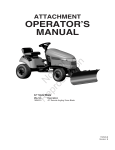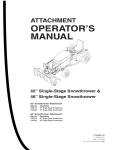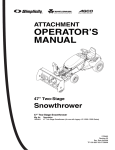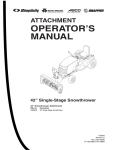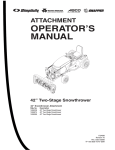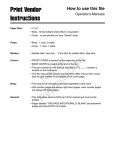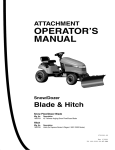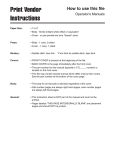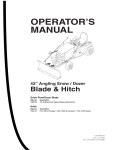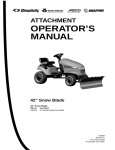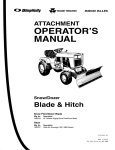Download White Outdoor Single-Stage Snow Thrower Operator`s manual
Transcript
ATTACHMENT No R e t fo pro r du cti on OPERATOR’S MANUAL 42” Single-Stage Snowthrower Model No. Description 1695969 42” Single Stage Snowthrower Copyright © 2011 Briggs & Stratton Power Products Group, LLC Milwaukee, WI, All rights reserved. 1751631 Rev: A 2 No R e t fo pro r du cti on Table of Contents Table of Contents 4 4 5 6 6 6 6 7 7 7 8 8 8 8 9 9 9 10 10 10 11 12 12 14 15 16 17 17 17 17 18 18 18 18 19 19 20 20 20 20 21 21 21 22 No R e t fo pro r du cti on Hardware ........................................................................................ Bag Contents ............................................................................ Box Contents ............................................................................. Operator Safety ............................................................................. Training...................................................................................... Preparation ................................................................................ Operation .................................................................................. Children ..................................................................................... Clearing a Clogged Discharge Chute ....................................... Service, Maintenance and Storage ........................................... Decals ....................................................................................... Accessories ................................................................................... Required Accessories ............................................................... Recommended Accessories ..................................................... Features & Controls ...................................................................... Control Functions ...................................................................... Tractor Controls ......................................................................... Assembly ....................................................................................... Unpacking ................................................................................. Chute Assembly ........................................................................ Install Hitch Assembly ............................................................... Attach Snowthrower to Tractor ................................................... Attach Lift Arm Assembly to Tractor ........................................... Attach Chute Motor Wiring Harness (Non-electric Deck Lift Models) ....... Attach Chute Motor Wiring Harness (Electric Deck Lift Models) ............ Install Reflectors ........................................................................ Operation ....................................................................................... Checks Before Starting ............................................................. Engine & Ground Speed Selection ............................................ Transporting ............................................................................. Snow Removal Suggestions ...................................................... Storage ........................................................................................... Daily Storage ............................................................................. Off-Season Storage................................................................... Troubleshooting, Adjustments & Service .................................. Troubleshooting Chart ............................................................... Skid Shoe Adjustment ............................................................... Electric Chute Rotator Gear ...................................................... Lift Adjustment .......................................................................... Belt Tension Adjustment ............................................................ Maintenance .................................................................................. Schedule for Normal Care ......................................................... General Lubrication ................................................................... Warranty ......................................................................................... NOTE: In these instructions, “left” and “right” are referenced from the operating position. 3 Hardware Bag Contents A - HITCH SUPPORT SHAFT B - HITCH LATCH PIN C - COTTER PIN D - HAIR PIN I - SWITCH G - SPRING H - AXLE CLAMP No R e t fo pro r du cti on F - TURNBUCKLE E - SAFETY CLIP (Qty. 2) J - UPPER WIRE HARNESS K - EXTENSION WIRE HARNESS - 26” L - CLIPS (Qty. 4) M - REFLECTORS (Qty. 2) 4 Hardware Box Contents O - LIFT ARM ASSEMBLY No R e t fo pro r du cti on N - CHUTE P - HITCH ASSEMBLY Q - LIFT ROD ASSEMBLY R - SNOWTHROWER 5 Operator Safety WARNING This machine is capable to amputating hands and feet and throwing objects. Read these safety rules and follow them closely. Failure to obey these rules could result in loss of control of unit, severe personal injury or death to you, or bystanders, or damage to property or equipment. The triangle in text signifies important cautions or warnings which must be followed. OPERATION TRAINING 1. Read, understand, and follow all instructions on the machine and in the manuals before operating this unit. Be thoroughly familiar with the controls and the proper use of the equipment. Know how to stop the unit and disengage the controls quickly. 1. Do not put hands or feet near or under rotating parts. Keep clear of the discharge opening at all times. 2. Never allow children to operate the equipment. Never allow adults to operate the equipment without proper instruction. 3. After striking a foreign object, stop the engine (motor), remove the wire from the spark plug, disconnect the cord on electric motors, thoroughly inspect the snowthrower for any damage, and repair the damage before restarting and operating the snowthrower. 3. Keep the area of operation clear of all persons, par-ticularly small children and pets. PREPARATION 4. If the unit should start to vibrate abnormally, stop the engine (motor) and check immediately for the cause. Vibration is generally a warning of trouble. No R e t fo pro r du cti on 1. Thoroughly inspect the area where the equipment is to be used and remove all doormats, sleds, boards, wires, and other foreign objects. 2. Exercise extreme caution when operating on or crossing gravel drives, walks, or roads. Stay alert for hidden hazards or traffic. Do not carry Passengers. 2. Disengage all clutches and shift into neutral before starting engine (motor). 3. Do not operate the equipment without wearing ade-quate winter outer garments. Avoid loose fitting cloth-ing that can get caught in moving parts. Wear foot-wear that will improve footing on slippery surfaces. 4. Handle fuel with care; it is highly flammable. (a) Use an approved fuel container. (b) Never add fuel to a running engine or hot engine. (c) Fill fuel tank outdoors with extreme care. Never fill fuel tank indoors. Replace fuel cap securely and wipe up spilled fuel. (d) Never fill containers inside a vehicle or on a truck or trailer bed with a plastic liner. Always place con-tainers on the ground, away from your vehicle, before filling. (e) When practical, remove gas-powered equipment from the truck or trailer and refuel it on the ground. If this is not possible, then refuel such on a trailer with a portable container, rather than from a gasoline dis-penser nozzle. (f) Keep nozzle in contact with the rim of the fuel tank or container opening at all times, until refueling is complete. Do not use a nozzle lock-open device. (g) Replace gasoline cap securely and wipe up spilled fuel. (h) If fuel is spilled on clothing, change clothing imme-diately. 5. Adjust the collector housing height to clear gravel or crushed rock surfaces. 6. Never attempt to make any adjustments while the engine (motor) is running (except when specifically recommended by the manufacturer). 7. Let engine (motor) and machine adjust to outdoor temperatures before starting to clear snow. 8. Always wear safety glasses or eye shields during operation or while performing an adjustment or repair to protect eye from foreign objects that may be thrown from the machine. 6 5. Stop the engine (motor) whenever you leave the operating position, before unclogging the collector/impeller housing or discharge guide, and when mak-ing any repairs, adjustments, or inspections. 6. When leaving the machine unattended, disengage the power take-off (PTO), lower the attachment, set the parking brake, stop the engine, and remove the key. 7. When cleaning, repairing, or inspecting make cer-tain the collector/impeller and all moving parts have stopped. Disconnect the spark plug wire and keep the wire away from the plug to prevent accidental starting. Do not run the engine indoors except for starting the engine or for transporting the snowthrower in or out of the building. Open the outside doors; exhaust fumes are dangerous. 8. Exercise extreme caution when operating on slopes. Do not attempt to clear steep slopes. 9. Never operate the snowthrower without proper guards plates, or other safety protective devices in place and working. 10. Never direct the discharge toward people or areas where property damage can occur. Keep children and others away. 11. Do not overload the machine capacity by attempting to clear snow at too fast a rate. 12. Never operate the machine at high transport speeds on slippery surfaces. Look behind and use care when operating in reverse. 13. Disengage power to the collector/impeller when snowthrower is transported or not in use. 14. Use only attachments and accessories approved by the manufacturer of the snowthrower (such as wheel weights, counterweights, or cabs). Operator Safety 15. Never operate the snowthrower without good visibility or light. Always be sure of your footing, and keep a firm hold on the handles. Walk, never run. 16. Never touch a hot engine or muffler. 17. Never operate the snowthrower near glass enclosures, automobiles, window wells, drop-offs, and the like without proper adjustment of the discharge angle. 18. Never direct discharge at bystanders or allow anyone in front of the unit. 19. Never leave a running unit unattended. Always disengage the auger and traction controls, stop engine, and remove keys. 20. Do not operate the unit while under the influence of alcohol or drugs. 2. Never store the machine with fuel in the fuel tank inside a building where ignition sources are present such as hot water and spacer heaters, or clothes dryers. Allow the engine to cool before storing in any enclosure. 3. Always refer to the operator’s manual for important details if the snowthrower is to be stored for an extended period. 4. Maintain or replace safety and instruction labels as necessary. 5. Run the machine a few minutes after throwing snow to prevent freeze-up of the collector/impeller. 6. If fuel is spilled, do not attempt to start the engine but move the machine away from the area of spillage and avoid creating any source of ignition until fuel vapors have dissipated. 21. Keep in mind the operator is responsible for accidents occurring to other people or property. 7. Always observe safe refueling and fuel handling practices when refueling the unit after transportation or storage. 22. Data indicates that operators, age 60 years and above, are involved in a large percentage of power equipment-related injuries. These operators should evaluate their ability to operate the unit safely enough to protect themselves and others from injury. 9. Always follow the engine manual instructions for proper start-up procedures when returning the unit to service. 8. Always follow the engine manual instructions for storage preparations before storing the unit for both short and long term periods. 10. Maintain or replace safety and instruction labels as necessary. 24. Snow can hide obstacles. Make sure to remove all obstacles from the area to be cleared. 11. Keep nuts and bolts tight and keep equipment in good condition. CHILDREN 12. Never tamper with safety devices. Check their proper operation regularly and make necessary repairs if they are not functioning properly. No R e t fo pro r du cti on 23. DO NOT wear long scarves or loose clothing that could become entangled in moving parts. Tragic accidents can occur if the operator is not alert to the presence of children. Children are often attracted to the unit and the operating activity. Never assume that children will remain where you last saw them. 1. Keep children out of the area and under the watchful care of another responsible adult. 2. Be alert and turn unit off if children enter the area. 3. Never allow children to operate the unit. 4. Use extra care when approaching blind corners, shrubs, trees, or other objects that may obscure vision. 13. Components are subject to wear, damage, and deterioration. Frequently check components and replace with manufacturer’s recommended parts, when necessary. 14. Check control operation frequently. Adjust and service as required. 15. Use only factory authorized replacement parts when making repairs. 16. Always comply with factory specifications on all settings and adjustments. CLEARING A CLOGGED DISCHARGE CHUTE 17 Only authorized service locations should be utilized for major service and repair requirements. Hand contact with the rotating impeller inside the discharge chute is the most common cause of injury associated with snowthrowers. Never use your hand to clean out the discharge chute. 18. Never attempt to make major repairs on this unit unless you have been properly trained. Improper service procedures can result in hazardous operation, equipment damage and voiding of manufacturer’s warranty. To clear the chute: 1. SHUT OFF THE ENGINE. 2. Wait 10 seconds to be sure the impeller blades have stopped rotating. 19. Check shear bolts and other bolts at frequent intervals for proper tightness to be sure the equipment is in safe working condition. 3. Always use a clean out tool, not your hands. SERVICE, MAINTENANCE, AND STORAGE 1. Check shear bolts and other bolts at frequent intervals for proper tightness to be sure the equipment is in safe working condition. 7 Operator Safety Accessories Safety Decals Accessories This unit has been designed and manufactured to provide you with the safety and reliability you would expect from an industry leader in outdoor power equipment manufacturing. Required Accessories Although reading this manual and the safety instructions it contains will provide you with the necessary basic knowledge to operate this equipment safely and effectively, we have placed several safety labels on the unit to remind you of this important information while you are operating your unit. • It is required that tire chains and two rear wheel weights or Quick Tach Weights are used. Never operate on slopes greater than 17.6% (10°). • A Lift Lever Kit is required for some of the models covered by this manual, and must be installed as part of hitch installation. Recommended Accessories All DANGER, WARNING, CAUTION and instructional messages on your unit should be carefully read and obeyed. Personal bodily injury can result when these instructions are not followed. The information is for your safety and it is important! The safety decals below are on your unit. If any of these decals are lost or damaged, replace them at once. See your local dealer for replacements. • For operation on slopes greater than 15% (8.5°), Quick Tach Weights, tire chains, and wheel weights are recom-mended. Never operate on slopes greater than 17.6% (10°). No R e t fo pro r du cti on These labels are easily applied and will act as a constant visual reminder to you, and others who may use the equipment, to follow the safety instructions necessary for safe, effective operation. • A rear-mounted weight box can also be added for additional traction. The maximum weight added to the tractor should not exceed 35 lbs. per wheel, plus 100 additional pounds in the rear weight box. PART NO. 1716532 PART NO. 1722674 Auger Danger Decal Discharge Chute Danger Decal PART NO. 1716531 Main Operation Warning Decal A T ON N OP RAT N T NO T RO R R AR T AR R R . PART NO. 1716540 Rear Wheel Weights Required 8 171654 Features and Controls C A B E No R e t fo pro r du cti on D Control Functions Tractor Controls The information below briefly describes the function of individual controls. Operating the tractor and attachment requires the combined use of these controls and additional controls whose operation is described in the tractor Operator’s Manual. Before you begin operating the tractor and attachment, make certain you have: Please take a moment and familiarize yourself with the name, location, and function of these controls so that you will better understand the safety and operating instructions provided in this manual. • Read and understood the instructions in the tractor Operator’s Manual. • Become thoroughly familiar with all of the tractor controls and their operation, including how to safely and properly start and stop the unit. • Practice driving in an open area, without the attachment, to become accustomed to the unit. A. Electric Chute Rotator Switch – On tractor models with electric height of cut switch.The electric height of cut switch will become the spout rotator switch. B. PTO Switch – Engages and disengages the PTO to start and stop the snowthrower. C. Manual Attachment Lift Lever – The attachment lift lever raises and lowers the attachment. To RAISE an attachment, depress the release button on top of the lever and pull back. To LOWER an attachment, depress the release button and move the lever forward. When lowering the attachment, be sure to push the lever fully forward into the locked position D. Deflector Lock Knob – The snowthrower discharge deflector angle can be changed by loosening the lock knob, changing the deflector angle and tightening the lock knob. E. Throttle Control – Always operate at FULL throttle. 9 Assembly Unpacking 1. Position box close to the tractor and carefully unpack and organize snowthrower parts. 3. Align chute (N, Figure 3) notch (*) on chute with housing chute ring tab (**) and slide chute into place. IMPORTANT: See Figure 1 for correct orientation of snow drive pulley hub. 2. If snow drive pulley hub orientation is incorrect, loosen set screw, remove and flip pulley to correct orientation and tighten set-screw. N * ** Figure 3 4. Rotate chute 180 degrees to front. Chute (N, Figure 4) opening should be facing front / center of machine. No R e t fo pro r du cti on CORRECT * INCORRECT Figure 1 Chute Assembly 1. Remove gear cover (*, Figure 2) from the snowthrower assembly by removing hex screw (**) and tilting the gear cover to disengage tab on opposite side of box. 2. Remove chute rotator gear (*,Figure 2) from shaft. * ** Figure 2 10 * Figure 4 N Assembly 5. Loosen the three nuts (*, Figure 5) on motor assembly. Replace chute rotator gear (**) onto shaft and mesh the teeth with chute ring gear (***). Slide motor assembly forward and tighten the hex bolts (*). 4. On underside of tractor frame, locate 11/16” holes approximately 14” forward from rear tire. Insert hitch support shaft (A, Figure 7). Secure with the cotter pin (C) on inside of frame and slightly bend longest leg up. IMPORTANT: The cotter pin must be located along the inside edge of the tractor frame. 5. Slide hitch (P, Figure 7) under tractor and lift to slide hitch mounting arms (*) over hitch support shaft slots(**). ** *** ** * Figure 5 A C 6. Replace gear cover over rotator gear mechanism and secure with the hex bolt (Refer to left side Figure 2.). No R e t fo pro r du cti on NOTE: Engage cover tab on gear box opposite of hex bolt. Install Hitch Assembly 1. Remove the mower deck. Refer to Tractor Operator Manual. 2. Turn the front wheels fully to the left. 3. Place hitch (P, Figure 6) on floor in front of tractor as shown. NOTE: If this is a new installation, cut the plastic ties holding the snow thrower drive belt for shipping, but do not remove the belt. P Figure 7 * P Figure 6 11 Assembly 6. Lift front of the hitch assembly (P, Figure 8) up to tractor hook-hitch (*). 4. Install the drive belt onto the snowthrower drive pulley (*, Figure 10) and then onto the tractor PTO pulley (**). 7. Slide hitch latch pin (B) through the mounting holes in the hitch frame. Secure hitch latch pin with the hair pin (D). NOTE: Keep the handle portion of the hitch latch pin towards the front of the tractor. ** * B D * Figure 10 No R e t fo pro r du cti on 5. Rotate the belt tension lever (*, Figure 11) upwards and towards the back of the tractor into the locked position (**). P Figure 8 Attach Snowthrower to Tractor * ** 1. Position snowthrower assembly in front of tractor. 2. Remove both saftey clips and mounting pins from the snowthrower. NOTE: Mounting pins and safety clips come preassembled to snowthrower assembly. 3. Align the hitch assembly mounting arms with the snowthrower mounting tabs, insert mounting pins (*, Figure 9) and secure with safety clips (**). * Figure 11 Attach Lift Arm Assembly to Tractor 1. On right side of tractor, remove the four (4) hex bolts (*, Figure 12) and nuts from hitch assembly. ** Figure 9 * Figure 12 12 Assembly 2. Attach lift arm assembly (O, Figure 13) to the tractor frame using the four hex bolts (*) and nuts from the previous step. * * 5. Assemble lift assist parts. Attach spring (G, Figure 15) to turnbuckle (F) and axle clamp (H). NOTE: Do not position the axle clamp over the axle rib. F G H Figure 15 O Figure 13 3. Install lift rod assembly (Q, Figure 14) and secure with safety clips (E). 6. Fully raise the snowthrower off the ground. 7. On the left side of tractor attach turnbuckle (F, Figure 16), spring (G) and axle clamp (H) onto snowthrower assembly eyebolt (*). No R e t fo pro r du cti on 4. Using lift arm, fully raise snowthrower off the ground into locked position. Distance from the collar to end of rod should be 3.75”. If not, lower the snowthrower to the ground and adjust the lifting collar (*, Figure 14). NOTE: The distance from ground to the snowthrower should be 4” - 5” when snowthrower is in fully raised and locked position. * Q F H G Figure 16 E 8. Adjust spring tension by rotating the turnbuckle (F, Figure 17) clockwise using a 9/16” wrench, until threads are no longer visible. F * 3.75” Figure 17 Figure 14 13 Assembly Attach Chute Motor Wiring Harness (Non-Electric Deck Lift Models) NOTE: Open hood on tractor for installing the wire harness. 1. Remove plug from tractor dashboard (*, Figure 18). 4. Locate the tractor power leads (Figure 21), red with yellow stripe (*) and black (**), at the base of steering column. Connect these leads, color to color, to the upper wiring harness (J). IMPORTANT: DO NOT use yellow and black power tractor lead. J * * Figure 18 ** No R e t fo pro r du cti on 2. Plug female connector of the upper wiring harness (J, Figure 19) into switch (I). Figure 21 5. Route the upper wiring harness along the right side of the tractor. J I 6. Connect the chute rotation wiring harness (*, Figure 22) from the snowthrower to the square black plug from the upper wiring harness (**). Position the wiring heat cover underneath the muffler. * Figure 19 3. Route the upper wiring harness (J, Figure 20) and switch (I) through opening in dashboard. Snap switch into dashboard to secure. I J Figure 20 14 Figure 22 ** * Assembly 7. Secure wiring harness in place with clips (L, Figure 23) to the frame rails. NOTE: Wire harness slack should be secured and not interfere with moving parts. Attach Chute Motor Wiring Harness (Electric Deck Lift Models) 1. Under right rear fender, locate and disconnect the electric height of cut motor plug (*, Figure 25). L * Figure 25 2. Plug white female connector end of 26” extension wire harness (K, Figure 26) into existing tractor wire harness. Install Reflectors No R e t fo pro r du cti on Figure 23 Install the two reflectors (M, Figure 24) onto the rear of the tractor seat deck. K M Figure 26 3. Route chute rotation wire harness (*, Figure 27) along the frame rail. Figure 24 * Figure 27 15 Assembly 4. Connect chute rotation wire harness (*, Figure 28) to the 26” extension wire harness (K). Install Reflectors Install the two reflectors (M, Figure 30) on the rear of the tractor seat deck M K * Figure 28 7. Secure wiring harness in place with clips (L, Figure 29) to the frame rails. L Figure 29 16 Figure 30 No R e t fo pro r du cti on NOTE: Wire harness slack should be secured and not interfere with moving parts. Operation WARNING If auger does not start and stop when engaging/ disengaging electric clutch, see your authorized dealer. Under no circumstances should you attempt to defeat the safety system. Checks Before Starting 1. Refer to the Maintenance & Adjustments sections of this manual and perform any needed service. Also, refer to the tractor Operator’s Manual and perform any required service. 2. Remove any objects from the work area which might be caught in, or thrown by, the auger. 3. Before starting the engine, clear the auger of any ice particles which may cause damage to auger. 4. Adjust the deflector and skid shoes to desired height. See Skid Shoe Adjustment and Deflector Adjustment. 5. Make sure all hardware is present and secure. Engine & Ground Speed Selection WARNING Perform the Safety System Interlock test found in your tractor Operator’s Manual. If tractor does not pass the test, do not operate the tractor. See your authorized dealer. Under no circumstances should you attempt to defeat the safety system. Use caution when clearing a snow covered area. Snow can cover objects such as curbs, drop-offs, and other obstacles. Be familiar with the area you are clearing. To prevent an explosion or fire, never store the tractor with fuel in the tank inside a building where an ignition source is present. NOTE: Always raise the snowthrower before turning or backing up to prevent damage to the unit. DANGER OPERATING ON SLOPES CAN BE DANGEROUS 1. Start the tractor engine. After a brief warmup, set engine throttle FULL. Operate the unit at a slow ground speed when driving onto slope. Avoid using brakes to control ground speed. 2. Lower the snowthrower. When operating on slopes that are greater than 15 % (8.5°) but less than 17.6%, use additional wheel weights or counterweights. No R e t fo pro r du cti on Starting and Stopping Never operate on slopes greater than 17.6% (10°) which is a rise of 3-1/2 feet (106cm) vertically in 10 feet (607cm) horizontally. 3. Engage the electric clutch switch. Snowthrower auger should rotate. Disengage the electric clutch switch. Snowthrower auger should stop. 4. Adjust the throttle to full speed. Select the proper ground speed. 5. To stop tractor movement, depress the clutch/brake pedal. To stop the snowthrower, disengage the electric clutch. Before leaving the seat, disengage the electric clutch, set the parking brake, stop the engine, remove the key, and wait for all moving parts to stop. In addition to counterweights, use extra caution when operating on slopes. Drive UP and DOWN the slope, never across the face, use caution when changing directions and DO NOT START OR STOP ON SLOPE. For additional traction, tire chains and a weight box can be added. Maximum weight added to tractor should not exceed 50 lbs. per wheel and 100 additional lbs. in weight box. Transporting 1. Disengage the electric clutch and then raise the snowthrower. 2. Adjust ground speed according to surface conditions. 3. Select a low ground speed when transporting on a slippery surface. 17 Operation Storage Snow Removal Suggestions Daily Storage • Determine the best snow removal pattern before beginning. 1. Run the snowthrower a few minutes after blowing snow to prevent freeze-up of auger. • Wind direction is an important factor to consider. Rotate the spout to discharge snow downwind. 2. Allow tractor engine to cool before storing in any enclosure. • Plan the pattern so that you avoid throwing snow on cleared areas and on yourself as you are operating. Off-Season Storage • When land contour permits, it is best to travel in the longest direction to minimize turning. • In very deep or heavy snow, it may be necessary to make the first pass with snowthrower partially raised, backing up every few feet and lowering the snowthrower to clear the snow left on the surface. Also, it may be necessary to slice off less than the full width of the auger or reduce ground speed. 1. Remove snowthrower from the tractor. 2. Use water pressure or a brush to thoroughly clean the housing. 3. Paint, or lightly coat with oil, any area where paint has been worn or chipped away. 4. Lubricate the snowthrower. 5. Store the snowthrower and hitch in a dry place. • If snow stops flowing freely from the spout, back away until the snowthrower clears itself. DANGER No R e t fo pro r du cti on Do not clean out discharge chute with hands. Contact with moving parts inside chute will cause serious injury. Use a clean out tool. Use the following procedure to remove objects or clear the chute: 1. Stop the engine. Remove key. 2. Wait 10 seconds to be sure the auger/impeller blades have stopped rotating. 3. Alway use a clean-out tool. DO NOT use your hands. DANGER If the auger stalls or the chute plugs, DISENGAGE THE ELECTRIC CLUTCH, STOP THE ENGINE AND REMOVE THE KEY. SET THE PARKING BRAKE. WAIT FOR MOVING PARTS TO STOP. Remove the foreign object or clear the spout with a piece of wood before restarting the engine. Never place hands into auger housing or spout to clear jammed object. Auger may rotate when object is removed. 18 Troubleshooting Troubleshooting While normal care and regular maintenance will extend the life of your equipment, prolonged or constant use may eventually require that service be performed to allow it to continue operating properly. The troubleshooting guide below lists the most common problems, their causes and remedies. See the information on the following pages for instructions on how to perform most of these minor adjustments and service repairs yourself. If you prefer, all of these procedures can be performed for you by your local authorized dealer. PROBLEM WARNING To avoid serious injury, perform maintenance on the tractor or snow thrower only when the engine is stopped and the parking brake engaged. Always remove the ignition key, disconnect the spark plug wire and fasten it away from the plug before beginning the maintenance, to prevent accidental starting of the engine. CAUSE/SOLUTION A. Electric clutch not engaged. Engage electric clutch. 1. Snowthrower auger does not rotate. B. Foreign material is blocking auger. STOP engine. Remove key. Unplug auger with piece of wood. Read WARNING on page 17. C. Drive chain broken. Replace parts as required. A. Electric clutch brake not operating properly. See your dealer. No R e t fo pro r du cti on 2. Auger does not stop when electric clutch is disengaged. A. Engine RPM too slow. Set throttle to FULL. 3. Auger rotates, but snow is not thrown far enough. B. Ground speed too fast. Use slow ground speed. C. Snow thrower discharge chute clogged. STOP engine. Remove key. Unplug discharge chute using the chute cleaning tool or a piece of wood. Read WARNING on page 17. A. Skid shoes not properly adjusted. Adjust skid shoes. 4. Scraper bar does not clean down to hard surface. B. Lift height out of adjustment. See ADJUSTMENTS section. C. No down pressure. See Hitch Installation Instructions. 5. Snowthrower picks up and throws stones on gravel drive. 6. Tractor does not have sufficient traction. A. Skid shoes not properly adjusted for ground surface. Adjust skid shoes. B. Too much downward pressure on snow thrower. Raise snowthrower slightly. A. Tractor too light at rear wheels. Use Quick Tach weights, wheel weights, and tire chains. A. Ground speed too fast. Reduce speed. 7. Tractor not stable on sloping surfaces. B. Tractor not properly weighted. See Recommended Accessories, page 6. C. Slope grade too steep. See Safety Section. Use Quick Tach weights, wheel weights, and tire chains. 8. Chute does not rotate. A. Rotator gears out of adjustment. B. Wire harness disconnected. 19 Troubleshooting Skid Shoe Adjustment Lift Adjustment On smooth surfaces such as concrete or asphalt, the scraper bar should scrape the surface. On surfaces such as gravel, the scraper bar should be set high enough so that it will not pick up debris. In the fully raised position the attachment should be 4”-5” off the ground. 1. Loosen the nuts securing the skid shoes (*, Figure 31). 1. Fully raise the attachment lift. The snowthrower should be approximately 4”-5” off the ground. If not, go to step 2. 2. Raise or lower the scraper bar to the desired height. Use wood blocks to hold the snow thrower in position. 2. Lower the snowthrower and adjust the front set collar (*, Figure 33) to achieve the correct lift height. 3. Set the skid shoes so that they are in contact with the ground and tighten the skid shoe nuts. 3.75” * * No R e t fo pro r du cti on Figure 31 Figure 34 Belt Tension Adjustment Electric Chute Rotator Gear 1. Remove the cover (*, Figure 32) and loosen the three screws (**) securing the electric chute rotator motor (***). 2. Adjust the motor so that the gear meshes with the discharge chute ring gear and tighten the adjustment screws. 3. Reinstall the cover. Adjust belt tension if the tension lever does not adjust belt tension properly. 1. Move belt tension lever to the released position (*, Figure 34). 2. Loosen bolt (**) on idler pulley (***), located on the left side of the hitch assembly. 3. Move idler pulley backwards or forwards to adjust snow thrower drive belt tension.Tighten bolt (**) 4 Move belt tension lever to the locked tension position (****). 5. Test snowthrower and repeat adjustment as needed. * *** ** *** * ** Figure 32 20 Figure 34 ** ** Maintenance WARNING To avoid serious injury, perform maintenance on the unit only when the engine is stopped and all moving parts have stopped. Always remove the ignition key before beginning maintenance or adjustments to prevent accidental starting of the engine. Maintenance Schedule Care Required Schedule Clean snow and ice from unit. After each use. Lubricate snowthrower. Every 10 hours or at least once a year. General Lubrication Lubricate the snow thrower as shown in Figure 28. Where an oil can is shown use 30 weight oil. Where a grease gun is shown, use lithium grease. Lubricate the following areas: No R e t fo pro r du cti on • Oil the chute deflector. • Grease the chute ring gear. • Grease the snow thrower-hitch pivot points. • Grease the auger shaft grease fittings. Figure 28 21 Warranty BRIGGS & STRATTON POWER PRODUCTS GROUP, L.L.C. OWNER WARRANTY POLICY LIMITED WARRANTY Briggs & Stratton Power Products Group, LLC will repair and/or replace, free of charge, any part(s) of the equipment that is defective in material or workmanship or both. Briggs & Stratton Corporation will repair and/or replace, free of charge, any part(s) of the Briggs and Stratton engine* (if equipped) that is defective in material or workmanship or both. Transportation charges on product submitted for repair or replacement under this warranty must be borne by purchaser. This warranty is effective for the time periods and subject to the conditions stated below. For warranty service, find the nearest Authorized Service Dealer using our dealer locator at www.BriggsandStratton.com. There is no other express warranty. Implied warranties, including those of merchantability and fitness for a particular purpose, are limited to one year from purchase or to the extent permitted by law. Liability for incidental or consequential damages are excluded to the extent exclusion is permitted by law. Some states or countries do not allow limitations on how long an implied warranty lasts, and some states or countries do not allow the exclusion or limitation of incidental or consequential damages, so the above limitation and exclusion may not apply to you. This warranty gives you specific legal rights and you may also have other rights which vary from state to state or country to country. WARRANTY PERIOD Consumer Use Commercial Use: 1 Years N/A No R e t fo pro r du cti on Item Equipment The warranty period begins on the date of purchase by the first retail consumer or commercial end user, and continues for the period of time stated above. “Consumer use” means personal residential household use by a retail consumer. “Commercial use” means all other uses, including use for commercial, income producing or rental purposes. Once product has experienced commercial use, it shall thereafter be considered as commercial use for purposes of this warranty. No warranty registration is necessary to obtain warranty on Briggs & Stratton products. Save your proof of purchase receipt. If you do not provide proof of the initial purchase date at the time warranty service is requested, the manufacturing date of the product will be used to determine warranty eligibility. ABOUT YOUR WARRANTY We welcome warranty repair and apologize to you for being inconvenienced. Warranty service is available only through servicing dealers authorized by Briggs & Stratton or BSPPG, LLC. Most warranty repairs are handled routinely, but sometimes requests for warranty service may not be appropriate. This warranty only covers defects in materials or workmanship. It does not cover damage caused by improper use or abuse, improper maintenance or repair, normal wear and tear, or stale or unapproved fuel. Improper Use and Abuse - The proper, intended use of this product is described in the Operator’s Manual. Using the product in a way not described in the Operator’s Manual or using the product after it has been damaged will void your warranty. Warranty is not allowed if the serial number on the product has been removed or the product has been altered or modified in any way, or if the product has evidence of abuse such as impact damage, or water/chemical corrosion damage. Improper Maintenance or Repair - This product must be maintained according to the procedures and schedules provided in the Operator’s Manual, and serviced or repaired using genuine Briggs & Stratton parts. Damage caused by lack of maintenance or use of non-original parts is not covered by warranty. Normal Wear - Like all mechanical devices, your unit is subject to wear even when properly maintained. This warranty does not cover repairs when normal use has exhausted the life of a part or the equipment. Maintenance and wear items such as filters, belts, cutting blades, and brake pads (engine brake pads are covered) are not covered by warranty due to wear characteristics alone, unless the cause is due to defects in material or workmanship. Stale Fuel - In order to function correctly, this product requires fresh fuel that conforms to the criteria specified in the Operator’s Manual. Damage caused by stale fuel (carburetor leaks, clogged fuel tubes, sticking valves, etc) is not covered by warranty. * Applies to Briggs and Stratton engines only. Warranty coverage of non-Briggs and Stratton engines is provided by the engine manufacturer. 22 23 No R e t fo pro r du cti on No R e t fo pro r du cti on Copyright © 2011 Briggs & Stratton Power Products Group, LLC Milwaukee, WI, All rights reserved.
























